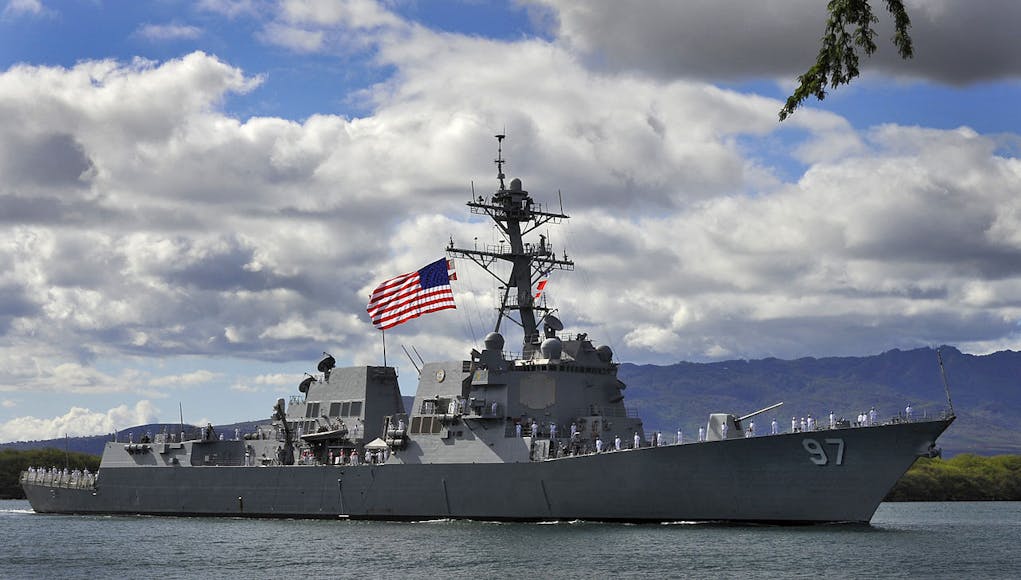BAE Systems in the U.S. has been awarded a £146 million contract by the U.S. Navy to carry out extensive maintenance and modernisation of the guided-missile destroyer USS Halsey (DDG 97).
The contract could potentially increase to £185 million if all additional options are exercised.
The project, which will be undertaken at BAE Systems’ San Diego shipyard, involves dry-docking the 509-foot warship, performing essential hull maintenance, and upgrading critical onboard systems.
This includes enhancing the ship’s Aegis combat system with the latest Surface Electronic Warfare Improvement Programme (Block 3) and upgrading its command-and-control systems. The crew’s living quarters will also be refurbished to improve conditions for the 260 sailors on board. The work is set to begin later this month and continue into 2026.
Eric Icke, Vice President and General Manager of BAE Systems San Diego Ship Repair, highlighted the significance of the work. “This type of deep-level maintenance is crucial to keeping the USS Halsey combat-ready,” he said. “Our team in San Diego is prepared to carry out the necessary upgrades and get the Halsey ready for the next phase of fleet readiness.”
The USS Halsey has been in service since 2005 and is named after Fleet Admiral William F. “Bull” Halsey, a legendary figure in the Pacific during the Second World War. BAE Systems’ San Diego shipyard has recently completed similar work on another destroyer, the USS Mustin (DDG 89), and this will mark their fifth major project of this kind.
The USS Halsey, an Arleigh Burke-class destroyer, is a formidable multi-mission warship with a displacement of 9,300 tons. Measuring 509.5 feet in length with a beam of 66 feet, the vessel is powered by four General Electric LM2500-30 gas turbines, generating 100,000 horsepower across two shafts.
This propulsion system allows the destroyer to reach speeds in excess of 30 knots (55+ km/h), making it a versatile and rapid-response vessel capable of high-speed engagements and quick deployment.
Armed with a wide range of weaponry, the USS Halsey boasts one 5-inch Mk 45 Mod 4 gun for surface engagements and a Phalanx CIWS for close-in defense against missiles and aircraft. It is also equipped with two 25mm Mk 38 machine guns and several .50-calibre guns for additional firepower.
The ship’s missile capabilities are provided by a 96-cell Mk 41 vertical launch system, capable of deploying a variety of munitions including RIM-66M and RIM-156 surface-to-air missiles, BGM-109 Tomahawk cruise missiles, and anti-submarine RUM-139 ASROC missiles. The ship’s anti-submarine warfare capabilities are further enhanced by two Mark 32 triple torpedo tubes, which can launch Mark 46, Mark 50, or Mark 54 lightweight torpedoes.














Wish we were putting 96 missile cells on our hulls……..or even 72
Trouble is, that many cells cuts into hull volume, thereby limiting further expansion.
Plus, when the class was designed it was generally necessary to fire 2 missiles per target to achieve a 75-80% chance of a hit. The T-45s need only 1 missile to achieve that, so with 48 cells that works out at the same number of interception attempts.
Not to mention, if I’ve read correctly, the T-45s are getting a 20-missile pack of CAMM (SeaCeptor) added on.
So similar capabilty in terms of missile firepower then ? Never thought of impact of cuts into hull to fit.
Absolutely, it’s all to easy to forget missiles are massive. If memory serves, the Arleigh Burkes have 96 Strike cells in 12 sets of 8. Those cells extend 7.7m (303 inches) into the hull – about 2 or 3 decks?
The Sylver A-50, on the other hand isn’t as deep at 5.0m, which would put it at about 1.5 decks?
Of course, the Arleigh Burkes launchers are far more flexible, and it’s effectively got deeper magazines. As a counterpoint though, should either ship be unfortunate to be destroyed at full load, the loss of 96+ missiles is going to hurt the USN. Heck, the loss of 48 of a Type 45 would hurt the RN.
The RN/MOD had the option of fitting Strike Length Sylver A70 Cells into the Type 45 but for whatever reason chose not too.
Well, the obvious answer to that is that as the type is intended as an air defence vessel, and the Aster missiles fit into the Sylver A50 cannisters, there is no need for a bigger launch cell.
Certainly logical from a general perspective – but I’m also sure that COs would rather be able to shoot back at surface vessels targeting them!
ISTR that the Type 45 was fitted ‘for but not with’ strike cells forwards of the superstructure? Though I also think these were intended to be units from the old Frigates rather than modern A70 units.
You are correct in that the A50 Cells are sufficient for the Aster 30 Missile variants currently in use,the question is will the future developments need the longer A70 ?.NL have today said that the Block 2 BMD is basically dead in favour of the future Aquila Project.With the Sea Ceptor Upgrade now underway it is very unlikely that the reserved space for the MK41 VLS will ever be exploited so late into the Ships lives.The NSM will stay Deck Launched for the foreseeable future.
Well, the obvious answer to that is that as the type is intended as an air defence vessel, and the Aster missiles fit into the Sylver A50 cannisters, there is no need for a bigger launch cell.
Though I would have thought being able to put the NSM into a VLS cell would be more efficient than mounting it on deck – and pretty sure they need A70s to do so